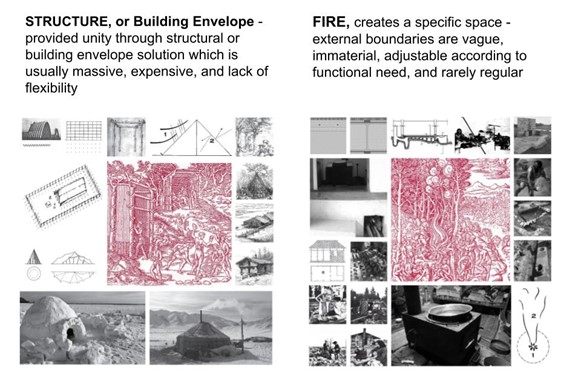Eunji Cho - CH

What made you decide to apply for a grant at the Leading House Asia?
Since primitive architecture, the architect and engineer need to work with finite resources and cope with natural forces of gravity, heat, cold, wind, snow, rain, flood, et cetera. Therefore, the theory and practice are strictly determined by these conditions. The problem and complications today are somewhat parallel to primitive architecture. Thus by the acquisition of the primi-tive/previous/nomad experience of the tribe or civilization, this project put emphasis on the sensa-tional experience and architectural responses that nomad people have always enjoyed. In this context, this project reconciles and integrates inseparable structure and mechanical equipment that developed independently of each other since the industrial revolution. This project has en-deavored to tolerate the parts of the structure (i.e. building envelope) that combine with certain mechanical services to provide the basic life support that makes a viable or valuable environ-ment.
How did you secure a host professor?
This partnership is the exchange based on the existing partnership between the Korean and Swiss research laboratories and researchers, Prof. Sung-Taeg Nam from Hanyang University and Prof. Khovalyg from École Polytechnique Fédérale de Lausanne. The partnership initially emerged from the joint participation in the international academic program ARC-HEST between Korea and Swiss in 2019. The collaborative project between the Laboratory of Integrated Comfort Engineering at EPFL with Architecture, Object, Urban Theory Lab at Hanyang University has a positive outlook on the close relationship between architectural composition alongside the specific engineering solu-tion.
How would you describe your experience of the programme?
The Korean fellow benefited from being based in Fribourg Smart Living Lab and Lausanne EPFL campus. The Laboratory of Integrated Comfort Engineering focuses on engineering and the Archi-tecture, Object, Urban Theory Lab focuses on architectural composition with different perspec-tives and methodologies on the buildings allowing this project to be interdisciplinary and well-thought to yield a novel perspective on some aspects of buildings. The multidisciplinary people, environments and laboratories encourage the fellow to consider multiple and simultaneous as-pects of architecture and civil engineering. The lecture series, seminars, laboratory meetings, and the events have also been the inspiration during the stay. Every single experiences with the peo-ple from the laboratories and EPFL have strengthened the fellow’s research throughout.
What role did the Leading House Asia play in the programme?
Financial and administrative support was provided by the Leading House Asia. Also, the initial settlement with the host institution (École Polytechnique Fédérale de Lausanne) was established by the Leading House Asia.
What were the impacts you made through the project/partners/individual?
During my stay at EPFL in the Laboratory of Integrated Comfort Engineering, “multifunctional elements” were investigated in relation to the two bioclimatic archetypes; ”building envelope and fire”. Using three strategies, respectively: separation, integration, and sensation. The first is an examination of the two bioclimatic archetypes of “multifunctional element”. Especially, the project demonstrates how the physical and functional separation and integration of the ‘building envelope and fire’ evolved in response to the bioclimate conditions. The distribution of the heat is the fo-cus of this project. The second is the reinforcement of the ‘multifunctional element’ to have a carrying capacity that can bear a load on top of a predetermined function. Ultimately, the project profitably propose that the two archetypes valid the function and order of each element and make “multifunctional element” vital as the central core in architecture. The hypothesis is that a “multi-functional element” is developed to complement finite natural resources primarily by minimizing the use of natural resources and maximizing the function. Occupants’ behaviour (i.e. lifestyle) in cold regions where fire and heat are most needed is explored. Besides, thermal comfort and thermal sensation in relation to architecture and engineering were reviewed during my stay at the Laboratory of Integrated Comfort Engineering at EPFL. Such research is beneficial in deepening the understanding of climate change as it has changed human settlement.
Testimonial: what were your personal experiences/thoughts on the bilateral cooperation experience?
As this project begins by tracing the genealogy of the ”multifunctional element”, the project cre-ates room for a discussion of the archetypes and the interdependency between the constructive and environmental techniques. The objective of the project is to answer the question of why the “multifunctional element” is vital as the central core and commit to distribution in architecture. In order to understand the interdependency between constructive and environmental techniques, the bilateral cooperation between the two laboratories (i.e., Architecture, Object, Urban Theory Lab and Laboratory of Integrated Comfort Engineering) made it possible to reconcile what had been conventionally kept separate before, architecture and engineering. Interpreting the three types of archetypes as (i) Structure, or Building Envelope, (ii) Fire, and (iii) Integrating type of 1 and 2 allows the explanation of the “separation” and “superposition or integration” methods of construc-tive and environmental techniques. The scope of the research encompasses the relationship be-tween ‘resource-function’ in relation to environmental techniques and the revolution of the tools related to constructive techniques locally and internationally.